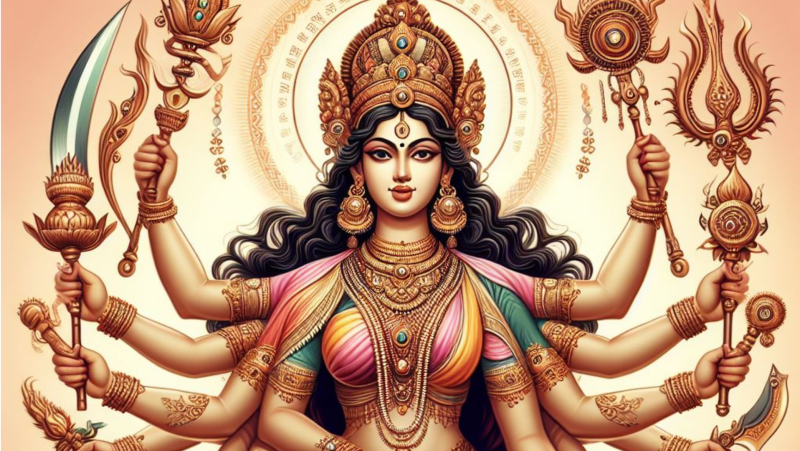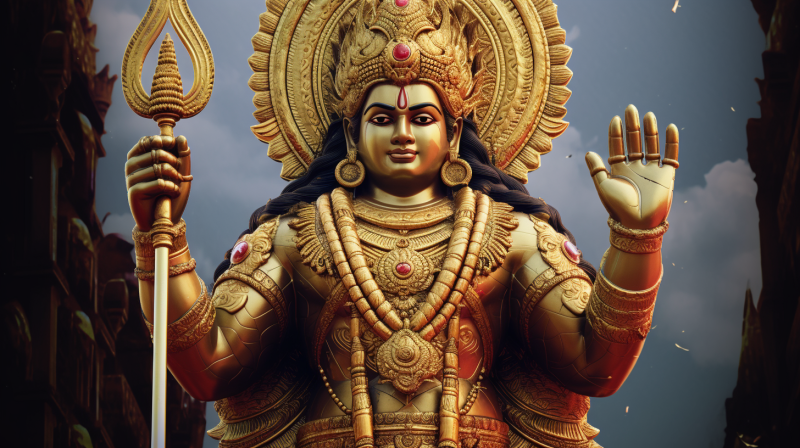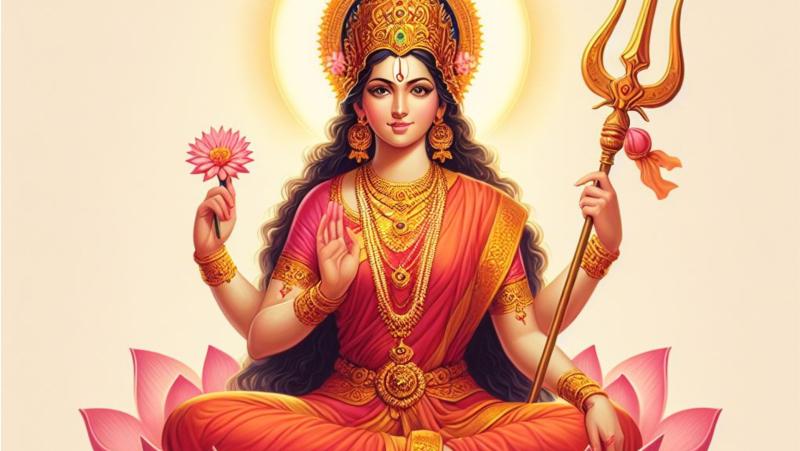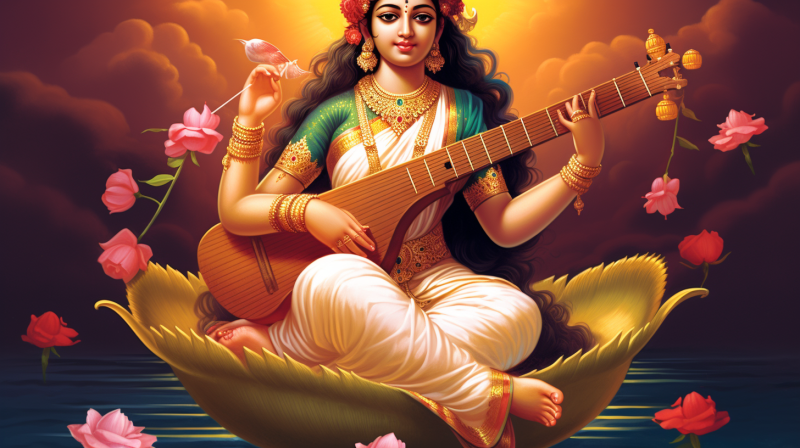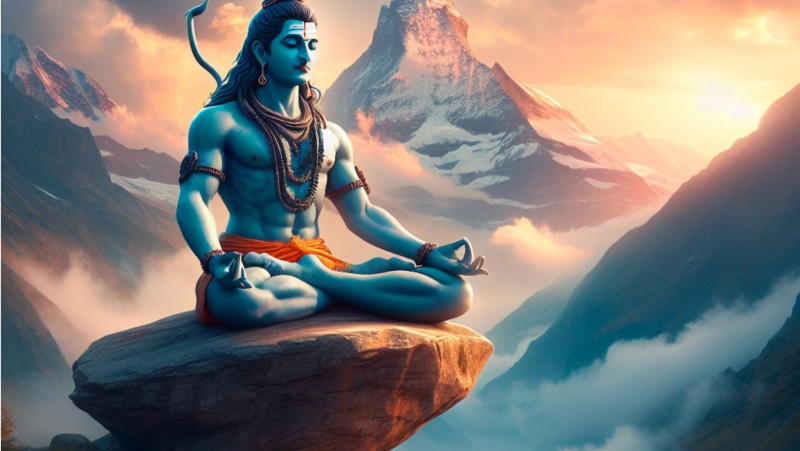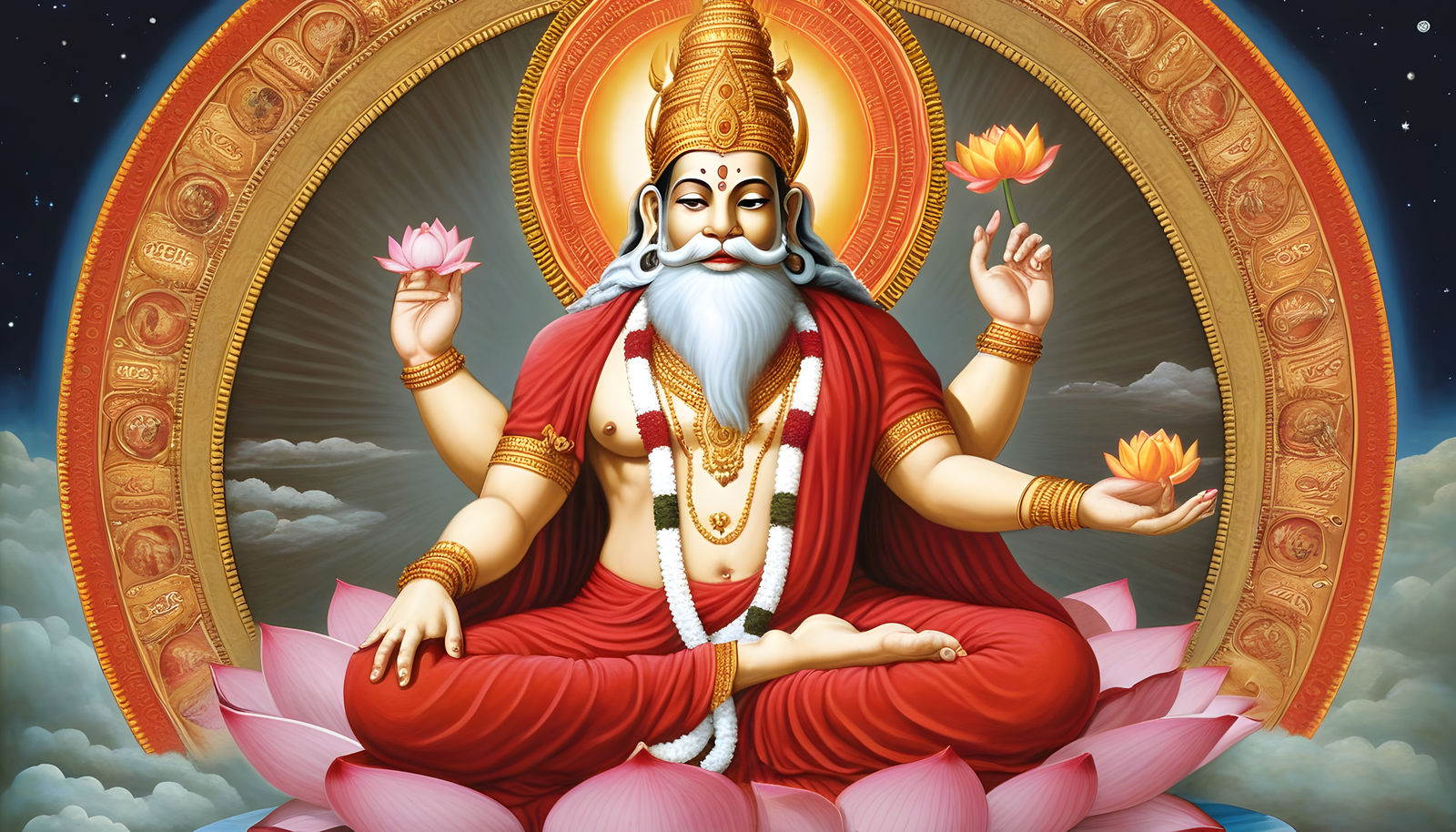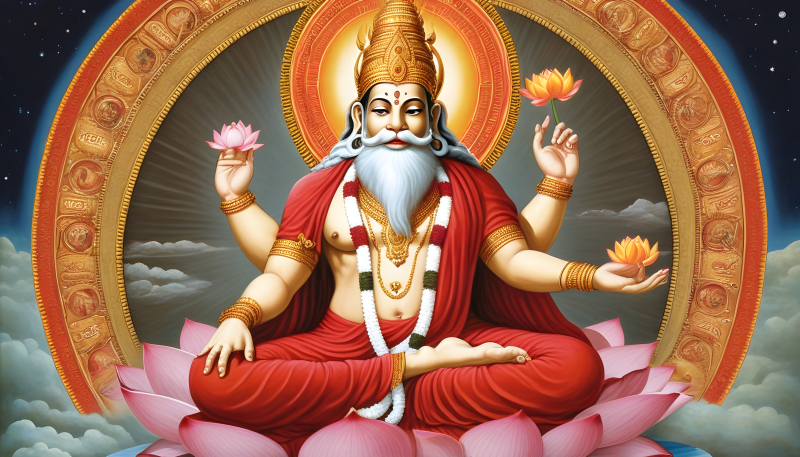
Brahma is a significant deity in Hinduism and is considered one of the Trimurti, which comprises the three major deities responsible for the creation, preservation, and destruction of the universe. The Trimurti consists of Brahma (the creator), Vishnu (the preserver), and Shiva (the destroyer). Here's some detailed information about Brahma:
Brahma is a prominent figure in Hindu mythology and is considered one of the principal deities in the Hindu pantheon. He is often referred to as the creator of the universe, responsible for shaping and bringing life to the world. Brahma's origins and mythology are deeply rooted in Hindu cosmology and religious beliefs.
Brahma Origin:
According to Hindu mythology, Brahma is said to have emerged from a golden egg that symbolized the primordial universe. This egg was called the "Hiranyagarbha," which translates to "golden womb." Within this egg, Brahma took form and began the process of creation. The emerging of Brahma from the golden egg represents the birth of the cosmos and the beginning of time.
Brahma Mythology:
Brahma's role as the creator is primarily highlighted in Hindu cosmogony. He is often depicted with four heads, each facing a cardinal direction, symbolizing his all-encompassing knowledge and presence. Brahma is usually depicted seated on a lotus flower, which signifies purity and divine birth, as the lotus is known to rise from the muddy waters untouched and pristine.
One of the most well-known myths involving Brahma is his creation of the universe, as described in the Hindu scripture known as the "Puranas." According to these texts, Brahma divided himself into two halves, creating a male half named "Manu" and a female half named "Shatarupa." Manu and Shatarupa became the first human beings and began populating the world.
Brahma is also associated with the creation of other important deities. He is said to have created the four Kumaras (Sanaka, Sanandana, Sanatana, and Sanatkumara) who are renowned for their devotion and wisdom. Another famous story involves Brahma creating the goddess Saraswati, the embodiment of knowledge, arts, and music.
Despite his role as the creator, Brahma is not as widely worshipped as other Hindu deities like Vishnu and Shiva. This is due, in part, to his limited presence in the scriptures and the narratives that surround him. There are relatively fewer temples dedicated exclusively to Brahma, and his worship has declined over the centuries.
A significant myth involving Brahma's status is the story of his fifth head. As per the Puranas, Brahma originally had five heads, symbolizing the five elements (earth, water, fire, air, and ether). However, during a confrontation with Shiva, a conflict arose, and in the course of this event, Shiva severed one of Brahma's heads as a form of punishment for his arrogance. This event is often cited as a reason for Brahma's limited worship and reverence.
Brahma's origins and mythology are intertwined with Hindu cosmology and the concept of creation. He is recognized as the creator of the universe, emerging from a golden egg, and is associated with the creation of humans and other deities. While not as widely worshipped as other Hindu gods, Brahma's presence in mythology remains a significant aspect of the Hindu religious tradition.
Brahma Role as the Creator:
Brahma is often referred to as "Brahma Deva" or "Brahmaji," signifying his role as the divine creator. According to Hindu cosmology, after the dissolution of the previous universe, Brahma is responsible for initiating the process of creation, giving form to the cosmos, and bringing life into existence. He is believed to have created the various realms, worlds, and beings that constitute the universe.
Brahma Role and Attributes:
Brahma is often referred to as "Brahma Deva" or "Brahma ji," signifying his role as the divine creator. According to Hindu cosmology, after the dissolution of the previous universe, Brahma is responsible for initiating the process of creation, giving form to the cosmos, and bringing life into existence. He is believed to have created the various realms, worlds, and beings that constitute the universe. Brahma is traditionally regarded as the creator of the universe, responsible for bringing everything into existence.
Brahma's primary responsibility is to create the universe, including the gods, humans, animals, and all other forms of life. He is said to have created the "Panchajana" (fivefold) classification system, which includes humans, animals, plants, celestial beings, and spirits. However, his role is often less emphasized in Hindu mythology compared to Vishnu and Shiva. While he is credited with the initial creation, his active involvement in the ongoing processes of the universe is not as prominent as that of the other deities.
Brahma Depictions and Symbolism:
Brahma is typically depicted with four heads and four arms, which represent his ability to see all directions simultaneously and symbolize his mastery over the four Vedas (sacred texts in Hinduism). He is often depicted sitting on a lotus flower, which is a symbol of purity and detachment from the material world. In some depictions, he holds a rosary, a water pot, a book, and a scepter. His four arms gracefully hold symbolic objects: one hand may cradle the Vedas, representing knowledge and wisdom; another hand may hold a water pot (kamandalu) that signifies the essence of life and creation; a third hand could be adorned with a rosary (mala), symbolizing the cyclical nature of existence; and the fourth hand might carry a lotus flower, emblematic of purity and detachment from the material world.
God Brahma is often depicted in Hindu art and iconography with various symbols and attributes that carry deep symbolism. These depictions and symbols help convey his role as the creator of the universe, as well as his qualities and significance within Hindu mythology and cosmology. Here are some common depictions and their associated symbolism:
1. Four Heads and Faces: Brahma is typically shown with four heads, each facing a different direction (north, south, east, and west). This portrayal signifies his all-encompassing knowledge and awareness, symbolizing his ability to oversee and be present in all aspects of creation simultaneously.
2. Lotus: Brahma is often depicted seated on a lotus flower. The lotus is a symbol of purity, beauty, and transcendence. It emerges from the mud but remains untouched and pristine, representing how Brahma creates the universe without being affected by the material world's impurities.
3. Four Arms and Attributes: Brahma is shown with four arms, each holding symbolic objects that represent various aspects of his divine attributes and cosmic responsibilities:
• Book or Vedas: One of Brahma's hands holds a book or the Vedas, symbolizing his role as the source of divine knowledge and wisdom that guides the creation process.
• Scepter or Mace: Another hand holds a scepter or mace, representing his authority and power as the creator.
• Water Pot (Kamandalu): The water pot is a vessel that holds water and is associated with the process of creation. It symbolizes the life-giving and purifying aspects of creation.
• Prayer Beads (Akshamala): The prayer beads signify cycles, time, and rhythm, highlighting Brahma's role in establishing the cyclical nature of creation, preservation, and dissolution.
4. Beard and Elderly Appearance: Brahma is often depicted as an elderly figure with a long white beard. This appearance represents wisdom, experience, and the timelessness of his role as the creator over countless cosmic cycles.
5. Consort and Swan: Brahma is typically depicted with his consort, Saraswati, who embodies knowledge, arts, and learning. She is often shown seated beside Brahma, reinforcing the concept that creation is closely tied to knowledge and wisdom. Additionally, Brahma is sometimes associated with a swan, which symbolizes discernment, purity, and the ability to separate truth from falsehood—a trait essential for creation.
6. Peacock Feather: In some depictions, Brahma is shown with a peacock feather in his crown or behind his ear. The peacock symbolizes beauty, grace, and vibrancy, and its inclusion may emphasize the aesthetic aspect of creation.
7. Fifth Head Myth: While not as commonly depicted, some artistic representations include Brahma with five heads, which alludes to the myth of his original five heads and their subsequent reduction to four by Shiva. This serves as a reminder of Brahma's humility and the importance of humility in the face of cosmic forces.
In Hindu art and iconography, these depictions and symbols collectively capture the multifaceted nature of Brahma's role as the creator, his connection to knowledge and wisdom, and his influence in maintaining the order and cyclical rhythm of the universe.
Brahma Consorts and Offspring:
In Hindu mythology, God Brahma is often associated with his consorts and offspring, each of whom plays a distinct role in the cosmic order and the perpetuation of creation. Brahma's consorts and progeny are essential aspects of his symbolism and mythology. Let's explore these relationships:
Consorts:
1. Saraswati: Saraswati is the primary consort of Brahma and is considered the goddess of knowledge, arts, music, and learning. She embodies the creative power of intellect and wisdom. Saraswati is often depicted as a graceful and learned deity, seated beside Brahma. She is associated with the flowing waters of knowledge and is often depicted holding a veena (a musical instrument) and a book, symbolizing her dominion over arts and education.
The union of Brahma and Saraswati represents the inseparable connection between creation and knowledge.
Offspring:
According to Hindu mythology, Brahma created several beings through the power of his mind, without any physical union. These beings are known as his "manasputras."
Here's a more expanded overview of some of Brahma's mind-born children:
• Angiras: Angiras is a revered sage known for his knowledge of sacred hymns and rituals.
• Atri: Atri is a sage known for his devotion and penance. He is the father of Sati, who later became the wife of Shiva.
• Bhrigu: Bhrigu is renowned for his wisdom and his contributions to Vedic literature.
• Chitragupta: Chitragupta is considered the divine bookkeeper who keeps track of deeds and destinies of beings, especially in the afterlife.
• Daksha: Daksha Prajapati is known for his role in the creation of various beings and creatures. He is the father of Sati and is involved in several mythological narratives.
• Himavan: Himavan is a mountain king, the father of Parvati (Goddess Shakti), and is associated with the Himalayas.
• Jambavan: Jambavan is a wise bear-like creature and a revered figure in the Ramayana epic.
• Kama: Kama is the god of desire and love, often depicted as a young deity wielding a bow of flowers.
• Kratu: Kratu is known for his austerity and dedication to the divine. He is one of the Prajapatis.
• Kumaras: The Kumaras, including Sanaka, Sanandana, Sanatana, and Sanatkumara, are eternal beings who embody purity and wisdom.
• Marichi: Marichi is a sage and one of the seven great Rishis (Saptarishi). He is known for his progeny and contributions to Vedic literature.
• Narada: Narada is a divine sage known for his role as a messenger, musician, and storyteller between different realms.
• Pulaha and Pulastya: These sages are Brahma's mind-born children, known for their contributions to religious texts and their roles in various mythological stories.
• Shatarupa: Shatarupa is often referred to as Brahma's daughter and is considered the universal mother. She is also known as "Saraswati."
• Svayambhuva Manu: Manu is considered the progenitor of mankind and the first human being according to Hindu mythology.
• Vashishtha: Vashishtha is a revered sage known for his wisdom, devotion, and contributions to Vedic knowledge.
Time and Duration: The concept of time in Hindu cosmology is measured in vast cycles known as "kalpas." Each kalpa is divided into four yugas (ages): Satya Yuga, Treta Yuga, Dvapara Yuga, and Kali Yuga. Brahma's day consists of a thousand cycles of these four yugas, and his night is of equal duration.
In Hindu cosmology, the concept of time is vast and cyclical, and it is often measured in immense cycles known as "kalpas." These kalpas represent the eons of creation, preservation, and dissolution of the universe. The notion of kalpas illustrates the expansive and cyclical nature of time in Hindu cosmology, with Brahma's role as the creator being intimately linked to these cosmic cycles.
Here's a deeper look at the concept of kalpas in Hindu cosmology:
1. Kalpa as a Cosmic Day: A kalpa is a unit of time that spans the cycle of creation, preservation, and dissolution of the universe. It is often described as a "Day of Brahma," signifying one complete cycle of his creative process. This cycle is immense and unfathomably long, symbolizing the cosmic scale of Hindu cosmology.
2. Duration of a Kalpa: The duration of a kalpa is vast and is often expressed in terms of cosmic years. A kalpa is said to consist of 4.32 billion human years, representing a mind-boggling expanse of time. This duration encapsulates the birth, existence, and eventual dissolution of the universe.
3. Components of a Kalpa: Within a kalpa, there are specific periods and events that unfold in sequence:
• Creation: At the beginning of a kalpa, Brahma initiates the process of creation, forming the universe, celestial bodies, and life forms.
• Preservation: The universe remains in a state of preservation, with its various elements maintained and sustained.
• Dissolution: Eventually, the universe goes through a period of dissolution, where all forms disintegrate, and the cosmos returns to a state of primal matter.
4. Cyclical Nature: Hindu cosmology views time as cyclical rather than linear. After the completion of a kalpa, the universe is dissolved, and a new cycle begins. This cyclical perspective mirrors the continuous rhythm of creation, preservation, and dissolution that governs the cosmos.
5. Brahma's Role: Brahma's role as the creator is crucial within the context of a kalpa. He initiates the process of creation at the beginning of each kalpa and presides over the unfolding of cosmic events. As the kalpa reaches its conclusion, Brahma's role shifts to overseeing the dissolution of the universe.
The concept of time in Hindu cosmology is embodied in the vast cycles known as kalpas. These kalpas represent the cosmic days of Brahma, each spanning billions of years and encompassing creation, preservation, and dissolution. This cyclic perspective on time emphasizes the eternal nature of cosmic processes, highlighting the impermanence of the material world while showcasing the cyclical renewal of the universe under Brahma's guidance.
Brahma Decline in Worship :
The decline in the worship of God Brahma in Hinduism is a multifaceted phenomenon influenced by various factors, including religious, mythological, and cultural elements. Here are some of the key reasons contributing to the decline in the worship of Brahma:
1. Limited Role in Ongoing Cosmic Processes: Brahma's primary role is that of the creator, responsible for initiating the process of creation and giving form to the universe. However, once creation is set in motion, his role becomes less active. This limited involvement in the ongoing cosmic processes diminishes the emphasis on his worship compared to deities like Vishnu and Shiva, who are perceived as having more dynamic and continuous roles in maintaining and renewing the universe.
2. Mythological Narratives: Brahma is associated with certain mythological stories that may have contributed to the decline in his worship. For example, there is a myth where Brahma is depicted as displaying arrogance and pride, which leads to a conflict with Shiva. In this story, Shiva severs one of Brahma's heads as a form of punishment. Such stories may shape perceptions of Brahma and impact his status as a deity worthy of extensive worship.
3. Lack of Prominent Temples: Compared to deities like Vishnu and Shiva, Brahma has fewer temples dedicated exclusively to him. The most famous Brahma temple is located in Pushkar, Rajasthan, and it remains one of the few temples dedicated primarily to Brahma. The scarcity of temples can contribute to a decline in worship since temples serve as focal points for religious devotion.
4. Shift in Religious Focus: Hinduism is a diverse and multifaceted religion with a wide array of deities, sects, and philosophical traditions. Over time, the focus of religious practices and beliefs may shift within different sects and communities. In some sects and regions, the worship of specific deities may take precedence over others, leading to variations in the popularity of different gods.
5. Complexity and Philosophical Focus: Brahma is associated with complex metaphysical concepts in Hindu philosophy, such as the nature of creation and the relationship between the individual soul (Atman) and the ultimate reality (Brahman). These philosophical aspects of Brahma's role may make him less accessible to the average worshipper, leading to a decline in his worship in favor of deities with more approachable and relatable attributes.
6. Local and Regional Practices: Hinduism is highly decentralized, and local and regional practices often play a significant role in shaping religious beliefs and rituals. In some regions, Brahma may continue to be an important deity in local traditions, while in others, his worship may have declined.
It's important to note that while Brahma's worship may have declined in some contexts, he still holds a significant place in Hindu cosmology and remains an integral part of the religion's mythology. The degree of emphasis on the worship of Brahma can vary widely among different communities and sects within Hinduism.
Brahma Names and Forms
Brahma, the Hindu god of creation, is known by various names and forms in Hindu mythology and religious texts. These names and forms represent different aspects of his divine attributes and roles. Here are some of the names and forms of Brahma:
1. Brahma: This is Brahma's primary name and is derived from the Sanskrit word "Brahman," which signifies the ultimate reality or universal consciousness. Brahma is the deity responsible for the creation of the universe.
2. Vedanatha: This name means "Lord of the Vedas." It highlights Brahma's association with knowledge and the sacred scriptures, as he is considered the source of the Vedas, which are the foundational texts of Hinduism.
3. Hiranyagarbha: This name translates to "the golden womb" or "the golden egg." It refers to Brahma's origin, as he is believed to have emerged from a golden cosmic egg, symbolizing the birth of the universe.
4. Prajapati: Prajapati means "Lord of Creatures" or "Lord of Progeny." This name emphasizes Brahma's role as the progenitor of all beings and the creator of life forms.
5. Chaturmukha: Chaturmukha means "four-faced." Brahma is often depicted with four faces, each facing a different direction, symbolizing his all-encompassing knowledge and presence.
6. Svayambhu: This name signifies "self-existent" or "self-born." It underscores Brahma's unique nature as the one who emerged without any procreation, directly from the cosmic void.
7. Rajapita: Rajapita means "father of all." It highlights Brahma's role as the cosmic father who gives birth to the universe and all living beings.
8. Jagadguru: Jagadguru translates to "teacher of the world." This name reflects Brahma's role as the source of knowledge and wisdom, especially in the context of creation and cosmic order.
9. Yajna Purusha: Yajna Purusha refers to the "sacrificial man" or the deity associated with rituals and sacrifices. Brahma's role as the creator often involves the performance of cosmic rituals.
10. Brahmanaspati: This name signifies "Lord of Prayer" or "Lord of Brahmins." It underscores Brahma's connection to sacred knowledge and rituals.
These various names and forms of Brahma collectively represent his multifaceted role as the creator, the source of knowledge, and the architect of the universe in Hindu mythology and cosmology.
Brahma Philosophical Significance
The philosophical significance of Brahma in Hinduism extends beyond his role as a deity responsible for the creation of the universe. Brahma holds a central place in Hindu philosophy, and his symbolism and attributes carry profound philosophical implications:
1. Brahman and Brahmanic Reality:
- Brahma as a Manifestation of Brahman: In Hindu philosophy, there is a concept known as "Brahman," which is the ultimate, formless, and transcendent reality—the unchanging, eternal, and all-pervading cosmic consciousness. Brahma is often viewed as a manifestation or aspect of this Brahman. While Brahma is associated with the creative aspect of Brahman, he is a limited, personal representation of the formless and infinite Brahman.
2. Creation and Maya (Illusion):
- Creation as an Expression of Maya: Brahma's act of creation serves as a philosophical metaphor for the concept of "Maya." Maya represents the illusory nature of the material world, where reality is veiled by appearances and the physical senses. Brahma's creation, while real within the context of the material universe, is considered an illusion (Maya) when compared to the ultimate reality of Brahman.
3. Cyclic Nature of Time:
- Brahma's Role in Cyclical Time: Brahma's involvement in the cyclical creation, preservation, and dissolution of the universe aligns with Hinduism's cyclical view of time. This cyclical perspective is tied to the idea of reincarnation and the soul's journey through multiple lifetimes until it attains liberation (moksha). Brahma's role highlights the transient nature of material existence and the eternal nature of the soul's journey.
4. Consciousness and Creation:
- Brahma as the Creative Intellect: Brahma is often depicted as having four heads, each symbolizing a direction and the all-encompassing nature of his knowledge. This underscores the connection between consciousness, intellect, and the act of creation. Brahma's creative power is seen as an extension of divine intelligence and knowledge, emphasizing the role of consciousness in shaping the material world.
5. Unity in Diversity:
- Brahma as the Source of Diversity: Brahma's creation results in a diverse and complex universe filled with myriad life forms and elements. This diversity is seen as an expression of the underlying unity of all existence (Brahman). The multiplicity in creation is a reflection of the oneness of Brahman, highlighting the interconnectedness of all beings.
6. Importance of Knowledge:
- Brahma and Knowledge: Brahma is closely associated with knowledge, as he is the source of the Vedas, the sacred texts of Hinduism. This underscores the philosophical significance of knowledge in spiritual growth and understanding the nature of reality.
Brahma's philosophical significance in Hinduism lies in his representation of several key concepts, including the relationship between the manifest and unmanifest aspects of reality (Brahman and Maya), the cyclical nature of time and existence, the role of consciousness in creation, the unity in diversity, and the importance of knowledge in spiritual evolution. Brahma's symbolism and mythology provide a rich philosophical framework for contemplating the nature of the universe and one's place within it in Hindu philosophical traditions.
In summary, Brahma is a deity in Hinduism responsible for the creation of the universe, although his worship and importance have diminished over time compared to other deities like Vishnu and Shiva. His symbolism and mythology hold significant philosophical meaning within the context of Hindu cosmology and spirituality.
Remember that interpretations of Hindu mythology can vary across different texts and traditions. While Brahma holds a central place in the creation process, his worship and importance have evolved over time within the broader context of Hindu beliefs and practices.
You may also like …
Are You The Proud Hindu?
The Trimurti
Create an account to join us and start taking part in conversations.
SIGNIN